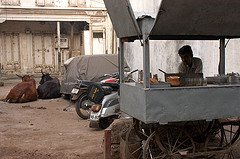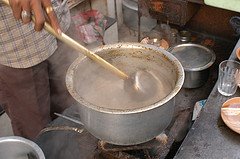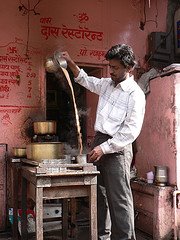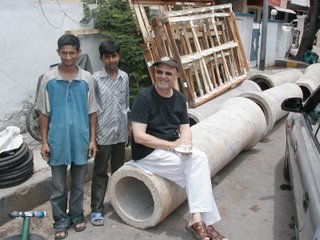MR. KOHLI AND THE SNAKES
One day, our back fence neighbor, Mr. Vibur Kohli called.
Mr. Kohli lives in a three and a half story mustard monstrosity of a house with undulant decks circling each floor. The top half story is shaped like the bridge of a tugboat, giving the overall impression of Noah's Ark plopped into the neighborhood. The reason I mention Mr. Kohli's architectural gaffe is because the back yard gardening strategy at our rented house has been to hide as much of Mr. Kohli's house as possible. We share a wall. His half is studded with broken bottles, ours is draped with jasmine.
Mr. Kohli called to tell me snakes were making their way via our jasmine to his back yard, threatening his peace of mind, and possibly his children's lives. He wasn't sure, but suspected cobras. His distress was alarming, and I promised to check into the situation.
The next morning while Reggie and I were on the verandah having our tea, Mr. Kohli's gardener appeared atop the wall and started hacking away at our vegetation. It felt like an act of war, so I rallied my single troop, and dispatched my gardener, Surender, to demand a halt to hostilities. Mr. Kohli appeared on his lower deck and accused me of reneging on our deal. I told him he was acting precipitously, that I had no intention of viewing his collection of broken glass, and that the jasmine was not to be touched. He then informed me that one of our trees was shadowing his yard and also needed a trim-back. At this point I suggested we leave it to the gardeners to reach an equitable and esthetic solution. He agreed. The entire conversation was held at a distance of about 100 feet, and though it seemed hostile, it was really just loud – two Captains shouting o’er the waves.
After I got to work I told the story to my friend Aravind, who suggested I hire a snake catcher to investigate both yards and bag up any offenders. I thought that was a great idea, and had visions of a snake-charmer in dhoti and turban, playing a beena and charming the snakes into burlap bags that would be carted to some wooded haven, or anywhere out of the neighborhood.
Aravind dispatched one of his lieutenants, Sanjay, into Delhi to find a snake catcher.
Sanjay returned a day later, begged our pardon, and relayed there were no snake-catchers to be found. Aravind, with a wink to me, sent him off to look again complaining he had let us down, and was obviously looking in the wrong places. For some reason Aravind suggested he look on the banks of the Jamuna River which flows through Old Delhi.
Sanjay returned two days later, sans snake-catcher, but with a bag of snake poison he thought we could sprinkle around the property. Snake poison? We decided against it because of the possible collateral damage to the cows and pigs foraging through the adjacent lot.
Aravind dismissed Sanjay with a disdainful flick of the wrist – and enjoyed every minute of the poor guy’s discomfort. Aravind admitted that snake catchers may be a thing of the past, or possibly of village life, but we were left without a solution to the problem.
When I got home I instructed Surender to accept no calls from Mr. Kohli. I hoped that whatever snakes there were would migrate.
Days passed and neither the snakes nor Mr. Kholi’s gardener made another appearance.
One of the things I like about India is that unattended problems tend to fade away with barely a ripple in the cosmic fabric while life takes care of itself.
When I next saw Mr. Kholi he was contentedly sailing his house into the sunset.
We waved cheerfully, and life went on.
Mr. Kohli lives in a three and a half story mustard monstrosity of a house with undulant decks circling each floor. The top half story is shaped like the bridge of a tugboat, giving the overall impression of Noah's Ark plopped into the neighborhood. The reason I mention Mr. Kohli's architectural gaffe is because the back yard gardening strategy at our rented house has been to hide as much of Mr. Kohli's house as possible. We share a wall. His half is studded with broken bottles, ours is draped with jasmine.
Mr. Kohli called to tell me snakes were making their way via our jasmine to his back yard, threatening his peace of mind, and possibly his children's lives. He wasn't sure, but suspected cobras. His distress was alarming, and I promised to check into the situation.
The next morning while Reggie and I were on the verandah having our tea, Mr. Kohli's gardener appeared atop the wall and started hacking away at our vegetation. It felt like an act of war, so I rallied my single troop, and dispatched my gardener, Surender, to demand a halt to hostilities. Mr. Kohli appeared on his lower deck and accused me of reneging on our deal. I told him he was acting precipitously, that I had no intention of viewing his collection of broken glass, and that the jasmine was not to be touched. He then informed me that one of our trees was shadowing his yard and also needed a trim-back. At this point I suggested we leave it to the gardeners to reach an equitable and esthetic solution. He agreed. The entire conversation was held at a distance of about 100 feet, and though it seemed hostile, it was really just loud – two Captains shouting o’er the waves.
After I got to work I told the story to my friend Aravind, who suggested I hire a snake catcher to investigate both yards and bag up any offenders. I thought that was a great idea, and had visions of a snake-charmer in dhoti and turban, playing a beena and charming the snakes into burlap bags that would be carted to some wooded haven, or anywhere out of the neighborhood.
Aravind dispatched one of his lieutenants, Sanjay, into Delhi to find a snake catcher.
Sanjay returned a day later, begged our pardon, and relayed there were no snake-catchers to be found. Aravind, with a wink to me, sent him off to look again complaining he had let us down, and was obviously looking in the wrong places. For some reason Aravind suggested he look on the banks of the Jamuna River which flows through Old Delhi.
Sanjay returned two days later, sans snake-catcher, but with a bag of snake poison he thought we could sprinkle around the property. Snake poison? We decided against it because of the possible collateral damage to the cows and pigs foraging through the adjacent lot.
Aravind dismissed Sanjay with a disdainful flick of the wrist – and enjoyed every minute of the poor guy’s discomfort. Aravind admitted that snake catchers may be a thing of the past, or possibly of village life, but we were left without a solution to the problem.
When I got home I instructed Surender to accept no calls from Mr. Kohli. I hoped that whatever snakes there were would migrate.
Days passed and neither the snakes nor Mr. Kholi’s gardener made another appearance.
One of the things I like about India is that unattended problems tend to fade away with barely a ripple in the cosmic fabric while life takes care of itself.
When I next saw Mr. Kholi he was contentedly sailing his house into the sunset.
We waved cheerfully, and life went on.






